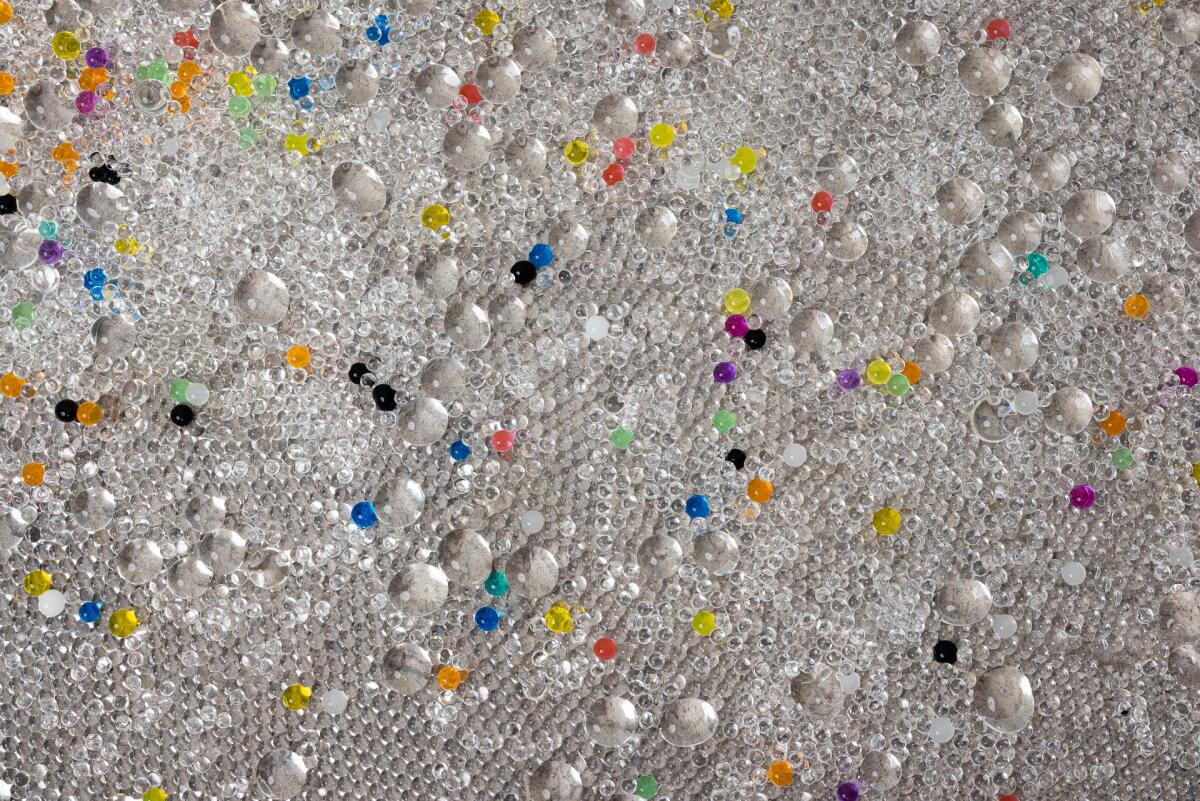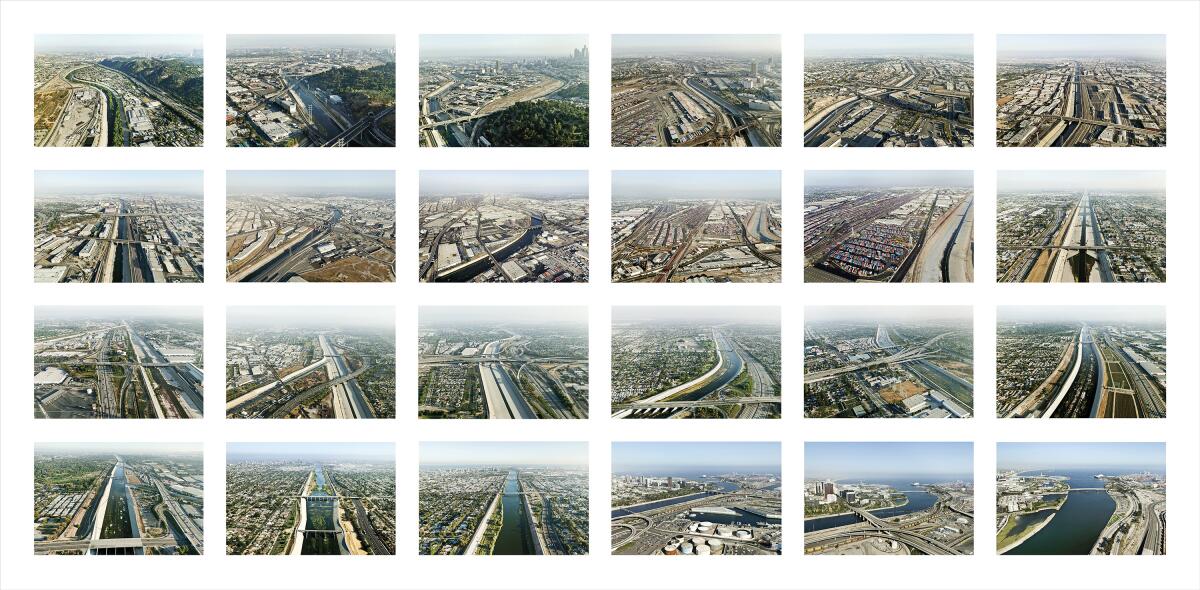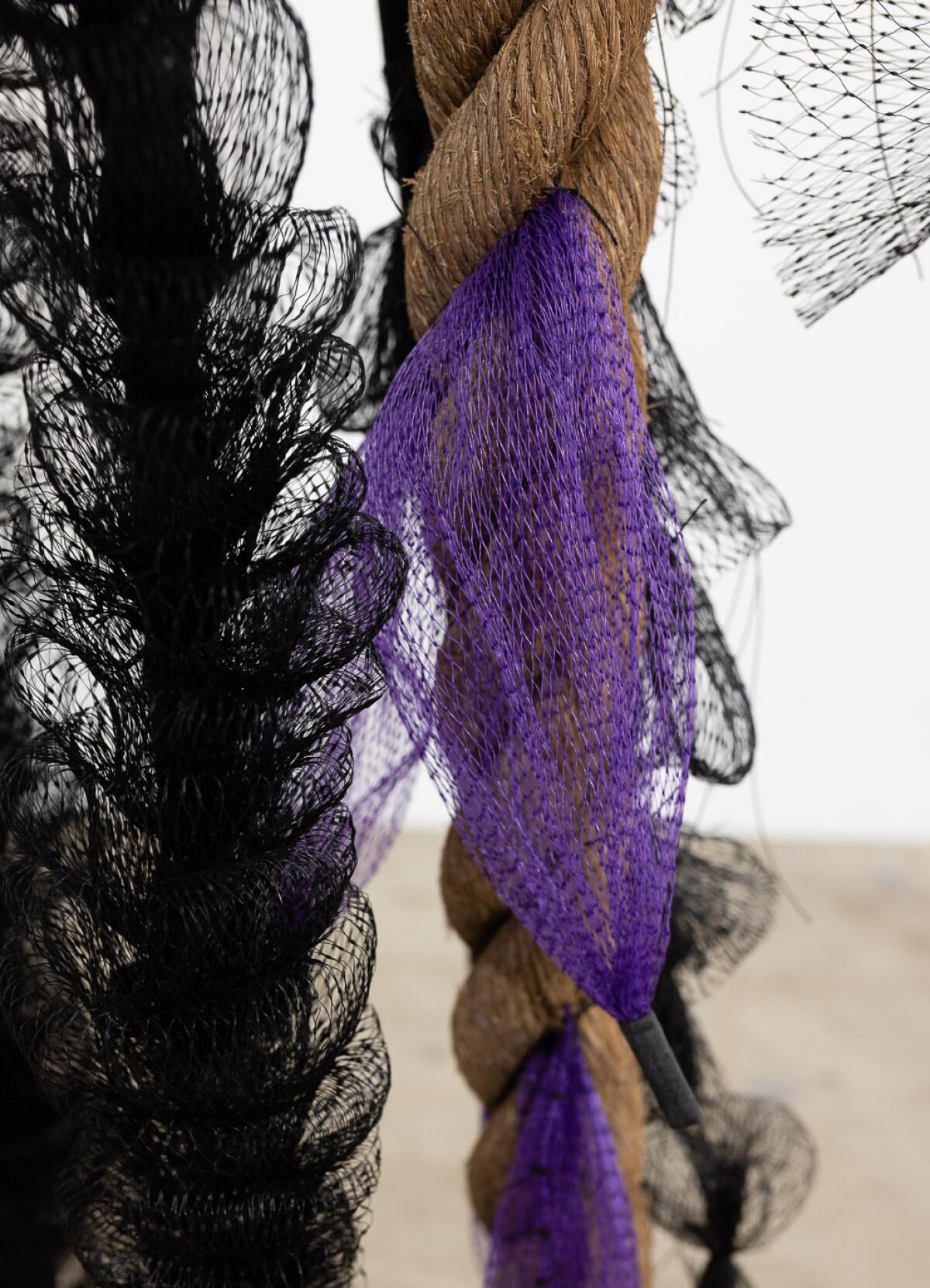L.A. artists take on drought crisis in new show. One solution? Embrace impermanence

- Share via
In many ways, the L.A. River altered the lives of gallerist Sean Meredith and artist Debra Scacco — though at different times and under different circumstances.
Meredith, director of Track 16 gallery downtown, didn’t care much for Los Angeles the entire first decade of living here after he relocated from New Jersey in 1992 — he saw the city as an inaccessible, concrete sprawl. Then he moved to Atwater Village in 2002 and began biking and taking long dog walks along the banks of the L.A. River, which he found surprisingly brimming with wildlife.
“It opened my eyes to a place whose infrastructure can be aesthetically a turnoff,” he says, “and I fell in love with L.A. the way you would a flower growing through a crack in the concrete.”
Meanwhile, Scacco — a research-based mixed media artist who grew up in New York and moved to L.A. from London in 2012 — was feeling lost. Literally. For years she’d been making work about maps and how cartography and geography impact our identities. Upon her arrival in L.A., she sought to understand the city’s geography using the river as a guidepost, as travelers often do in new cities. She visited a bookstore and asked for a map that showed the L.A. River prominently and was met with utter bewilderment by the store clerk. An hourlong scavenger hunt ensued that resulted in a map with a poor representation.
“I became obsessed with trying to find the river,” Scacco says, “because in L.A. we use freeways as those guideposts — it’s an ‘east or west of the 405’ conversation. How can the thing that gives a city life also be totally ignored?”
Research about the L.A. River and how it has shaped the city has informed her work ever since.

In late 2021, Meredith paid a visit to Scacco’s Lincoln Heights studio and the conversation naturally flowed to water. They talked for hours over coffee about aqueducts and dams, devastating drought and the history of water in L.A. dating back to the mid-1800s when a flood realigned the L.A. River.
The result is “Confluence,” a group exhibition Scacco curated at Track 16 featuring mixed media work by nine local artists exploring a range of water issues.
“We hope these works will encourage people to participate in water politics,” Scacco says in this edited conversation, “and to support local efforts to alleviate the water crisis.”
Water is such a broad and charged topic — how did you focus the exhibition and what parameters did you give artists, if at all?
Sean and I began with no parameters at all. Simply hours of conversation about the Los Angeles River and what it means — to each of us personally, to how the city is structured, to the water crisis, to the future of Los Angeles. We realized that at the root of each of these topics is the attempt to dominate nature through channelization. We discussed this focus with each artist and selected works that engage in at least one aspect of the human attempt to control the Los Angeles River and to treat water as a commodity to be owned.
Most Angelenos have a somewhat complicated relationship to water — what issues, specifically, do the works in the show touch on?
Robbing the Los Angeles River of its breath is an unmistakable act of colonization. The show addresses a range of impacts of this: communities fighting for survival, water scarcity resulting from infrastructure and climate change, manufactured permanence and what settles downstream. Each of these topics are within the feedback loop of channelization. We also asked each artist to make an advocacy recommendation, which can be found on the Track 16 site and the exhibition poster.

The idea of impermanence — of objects, of the natural landscape — runs throughout the exhibition. Can you elaborate on that?
The importance of impermanence seems ever more critical as we push against a UN prediction of climate catastrophe by 2040. Western thought leans toward the absolute, as though nature is static and infrastructure should remain intact indefinitely. Works in “Confluence” counter this by celebrating impermanence as part of the solution.
We see this in Emma Robbins’ “LA River Paper,” which collects organic material from the concrete channel and lovingly assembles it into living paper. Lauren Bon’s “Evaporation Pond” poetically evidences what remains after rain water evaporates. Lane Barden’s “Linear City” (2004/22), a series of photographs systematically documenting the 51 miles of the Los Angeles River, charts the forced permanence of nature itself.
Tell us about your own work in the exhibition, formally and conceptually.
“Siphon: Los Angeles River, Tributaries” addresses the interconnectedness of infrastructure and ecology and the conflicting time scales in which they operate. The work on paper begins with evidence of the separation of oil and water as guided by the wind. This process creates a topographic landscape inferring geological time. The drawing is then coated with several layers of beeswax: sealing, burying and halting the natural progress of these topographies. Finally, contemporary water systems are carved into the wax at varying thicknesses. Some are accentuated by thin lines of ink, while others appear only as traces. These representations of scars on the landscape chart extraction, diversion and the false sense of permanence that we must now reckon with.

How does materiality factor into the show? Some of the artists incorporate materials into their work that came from the L.A. River, including algae, leaves and even water?
A key commonality among this group of artists is the conceptual relevance and sensitivity of materials. Bridget DeLee’s “InBetween,” composed of found palm crowns and synthetic hair, creates a life-form that is of both the soil and the city. Blue McRight’s delicate counterbalanced sculpture, composed of collected trash and salvaged rope, reminds us that the Pacific is downstream from urban storm drains and sewers. Alicia Piller’s “Extinction” is a biomorphic topography of synthetic materials suggesting a downstream organism. Each work uses the material vernacular of the river and its detritus to create a third space that is both foreign and familiar.
Kori Newkirk’s assemblage piece was actually sculpted by forces in the L.A. River. How so?
To create “DTR,” Kori Newkirk collected several gallons of L.A. River water from a location near his downtown studio. Super absorbent polymers (SAPs) were then soaked in this water for several days, and arranged on a bed of clear vinyl. If SAPs are not rehydrated, the polymers shrink in size until there is virtually nothing left. “DTR” mirrors the natural process of replenishing aquifers that has been disabled by channelizations and forecasts the disappearance of water in the American West.
'Confluence'
Where: Track 16 gallery, 1206 Maple Ave., Suite 1005, Los Angeles
When: Through Sept. 3
Cost: Free
Info: www.track16.com
More to Read
The biggest entertainment stories
Get our big stories about Hollywood, film, television, music, arts, culture and more right in your inbox as soon as they publish.
You may occasionally receive promotional content from the Los Angeles Times.











